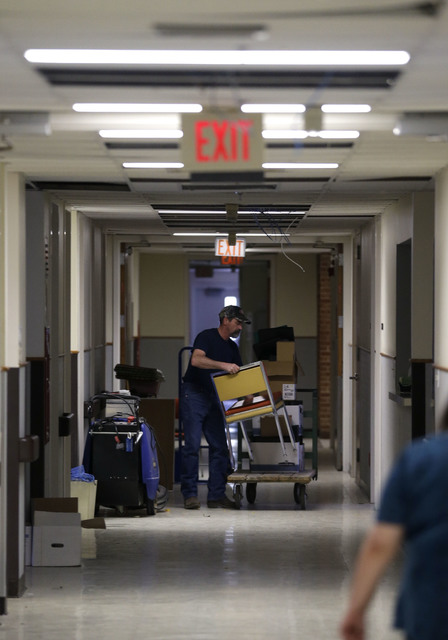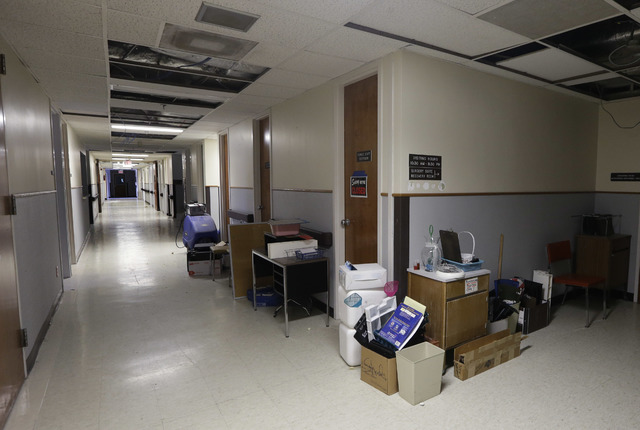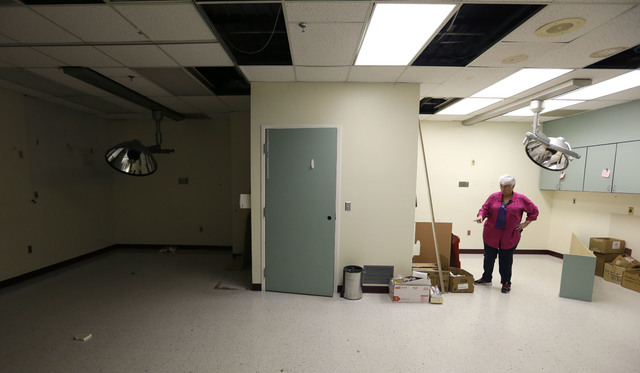Rural hospitals struggle to stay open, adapt to changes
OSCEOLA, Mo. — After 45 years of providing health care in rural Missouri, Sac-Osage Hospital is being sold piece by piece.
Ceiling tiles are going for 25 cents, the room doors for an average of less than $4 each, the patient beds for $250 apiece. Soon, the remnants of the hospital that long symbolized the lifeblood of Osceola, population 923, will be torn to the ground.
Sac-Osage is one of a growing number of rural U.S. hospitals closing their doors, citing a complex combination of changing demographics, medical practices, management decisions and federal policies that have put more financial pressure on facilities that sometimes average only a few in-patients a day.
“Money just kept drying up,” said Chris Smiley, a former operating-room nurse who was the last chief executive of Sac-Osage and is now overseeing its liquidation.
Standing near the doorway of a room stripped of its cabinets and sinks, Smiley stared down a hospital hallway where a man was carting off $1 boxes of unwanted items — pencils, plastic X-ray covers, a fish bowl, even a fly swatter.
“It’s sad to walk around here,” she said, shaking her head.
A total of 50 hospitals in the rural U.S. have closed since 2010, and the pace has been accelerating, with more closures in the past two years than in the previous 10 years combined, according to the National Rural Health Association. That could be just the beginning of what some health care analysts fear will be a crisis.
An additional 283 rural hospitals in 39 states are vulnerable to shutting down, and 35 percent of rural hospitals are operating at a loss, according to iVantage Health Analytics, a firm based in Portland, Maine, that works with hospitals.
Most of the rural hospital closures so far have occurred in the South and Midwest. Of those at risk, nearly 70 percent are in states that have declined to expand Medicaid under the federal Affordable Care Act, although some experts are hesitant to draw a cause-and-effect correlation.
In some cases, the shuttered hospitals have been replaced by clinics offering urgent care and other outpatient services. The site of the old Sac-Osage Hospital, which closed in September, could eventually become part of a walk-in health clinic. But other closures have simply left a void.
“When a hospital closes, the physicians leave. A lot of the health care infrastructure leaves. Sometimes the local businesses will leave … the schools suffer,” said George Pink, deputy director of the Rural Health Research and Policy Analysis Center at the University of North Carolina. “There’s a whole multiplier effect that really can devastate some towns.”
Big city hospitals have been closing at about the same rate as rural ones during the past five years, but an abundance of alternatives in most major metropolitan areas typically reduces the effect on patients. When a rural hospital closes, people might have to travel dozens of miles to reach the nearest hospital, an inconvenience that can sometimes be a matter of life or death.
When 18-month-old Edith Gonzalez choked on a grape in August 2013, her parents rushed to Shelby Regional Medical Center in their hometown of Center, Texas, unaware that the hospital had closed several weeks earlier. Their daughter was dead by the time an ambulance brought her to the next nearest hospital, more than 45 minutes later.
Kathy Hagler, whose family owns a local grocery store, helped Edith’s relatives gather 1,500 petition signatures pleading with state and local officials to re-open the hospital. But nothing has come of it.
“I didn’t want baby Edith to be forgotten,” Hagler said, “because we had no hospital here, and that could have saved her life.”
In rural North Carolina last summer, 48-year-old Portia Gibbs died from cardiac arrest after waiting 90 minutes for a medical helicopter to arrive. She could have been at a hospital in less than half that time, had not the Vidant Pungo Hospital in Belhaven closed just six days earlier.
Her death prompted Belhaven’s mayor to walk 273 miles to the nation’s capital in an attempt to raise awareness about the plight of rural hospitals.
Mayor Adam O’Neal plans to lead a similar march June 1 with supporters from at least 41 states. The city now is trying to acquire the old hospital through eminent domain and is seeking $6 million in federal loans to re-open it.
Since Gibbs’ death, O’Neal said, several other people have died before they could make it to more distant hospitals, including a 16-year-old boy hurt in a farming accident in April.
“We have people needlessly dying,” O’Neal said.
Since Belhaven lost its hospital last July, rural hospitals also have shut down in other states, including Mississippi, Ohio, Tennessee and Texas.
Parkway Regional Hospital in Fulton, Kentucky, was pronounced closed at 11:59 p.m. on March 31 after three decades in operation. Interim chief executive Dana Lawrence said annual patient admissions had fallen by half since 2010, to an average of less than two a day.
A steady decline in population, a depressed local economy and changes in inpatient admission guidelines were the prime factors.
Those same factors have played a role in numerous other hospitals closures. Rural areas tend to “have older, poorer, sicker populations,” said Michael Topchik, senior vice president of iVantage.
That means they often have a higher percentage of patients covered by Medicare and Medicaid, government health care programs that pay a lower reimbursement rate than private-sector insurers. Hospitals that rely heavily on those programs have been particularly hard hit by federal budget cuts and provisions in the 2010 federal health care law that reduced charity care reimbursements and linked a portion of hospitals’ Medicare payments to quality standards and readmission rates.
The effects of the federal health care law were the prime factor leading East Texas Medical Center to close three of its 12 rural hospitals last year, said Perry Henderson, the hospital system’s senior vice president for affiliate operations.
“The small rural hospitals are the most brittle of the bunch,” Henderson said. “When you began cutting on those reimbursements, it hits their margins and pretty quickly drives those hospitals to some pretty significant losses.”
The framers of the federal health care law assumed the cuts would be offset as more patients became covered by private insurance and Medicaid. But Texas, which has the nation’s highest uninsured rate, is among 21 states mainly in the South and Great Plains that have declined to expand Medicaid eligibility.
The trend also has reached into California, where the booming economy along the coast contrasts with Central Valley agricultural communities that have been devastated economically by years of drought. Many residents remain uninsured or have Medicaid.
A hospital serving the farming community of Corcoran closed in 2013, leaving residents with a clinic but no emergency room or major medical service.
Corcoran District Hospital buckled financially in part from treating residents without adequate insurance. In a second blow, a state prison within the city limits scaled back its contract with the hospital, diminishing an important source of revenue, said Jerry Robertson, the mayor and a pharmacist.
“If you have a heart attack, you have to travel 20 miles without dying,” he said.
At Sac-Osage, poor management was among the reasons the rural Missouri hospital fell into financial ruin. Some of its doctors, for example, were never approved to be paid by particular insurance companies. And it lost what some staff estimate was $1.5 million to $2 million because the clinic failed to send out thousands of bills to insurers and patients since 2012.
One local doctor made a last-ditch effort to buy Sac-Osage for $150,000. But the hospital board rejected his proposal as too vague and too late, deciding instead to close the facility and use part of its continuing tax revenue to pay for an ambulance service run by a hospital in a larger town 35 miles to the south.
For state Rep. Warren Love, a local cattle rancher who tried to help save Osceola’s hospital, its passing now seems sort of inevitable.
“Everything has evolved to the big gets bigger and the littlest disappears,” Love said, “and that’s really what’s happened with these hospitals.”
———
Associated Press Writer Scott Smith in Fresno, California, contributed to this report.





